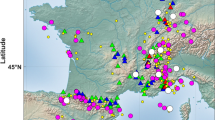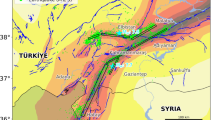Abstract
The process of earthquake appearance in its focus is analyzed on the basis of the oscillation theory. The earthquake focus consisting for simplicity of two blocks (granitic and basaltic) is studied mathematically and physically. The block sizes, density and Young's modulus of the rocks composing these blocks are considered to be known. We assume that the blocks are located on an edge of a regional tectonic fault. The tectonic plate or subplate, moving with a given speed u of shearing, is on the other edge of the fault. The mechanical interaction of the fault edges is due to the friction, which depends on the relative velocity V = u − dx/dt, where x is a coordinate of the concrete block. Physical-mathematical equations of block motion are solved using analytical methods. As a result, we find complete information about seismic vibrations in the focus and their characteristics. The evolutions of kinetic, potential and total energy as well as the function of dissipation in the focus and magnitude of the earthquake are calculated. The computations were carried out at different speeds of movement u. This allowed us to study the dependence of the earthquake magnitude on the velocity u of the main plate. The constructed original model of the earthquake focus unmasks the mechanism of seismic oscillations and their properties.
















Similar content being viewed by others
Abbreviations
- A :
-
Amplitude of the Berlage's impulse in Eq. (28)
- a :
-
Side of a block
- B:
-
Berlage's impulse in Eq. (28)
- b :
-
Dimensionless empirical constant in Eq. (8)
- C :
-
Dimensionless constant of integration in Eqs. (34), (40), (41)
- c :
-
Dimensionless connectedness of blocks
- D :
-
Dimensionless value in Eq. (19)
- d :
-
Normalization factor for function Dis
- Dis:
-
Dissipation function in Eq. (1)
- E :
-
Total energy (Lagrange's function) in Eq. (1)
- F :
- F max :
-
Maximal force of an earthquake
- G :
-
Block loading in Eq. (7)
- g :
-
Gravity acceleration
- h :
-
Coefficient for lateral friction in Eq. (4)
- In :
-
Interval, i.e. distance between blocks
- J :
-
Young's modulus
- K E :
-
Energy class of an earthquake
- K j :
-
Constant of integration
- k :
-
Coefficient of elastic stiffness in Eq. (3)
- L :
- M :
-
Earthquake magnitude in Eq. (55)
- m :
-
Mass of block
- N :
-
Dimensionless load
- n :
-
Normalization factor for interval In
- O :
-
Dimensionless operator of the time differentiation in Eqs. (13), (14)
- P max :
-
Maximal pressure of an earthquake
- p :
-
Dimensionless empirical constant in Eq. (8)
- Q :
-
Dimensionless value in Eq. (20)
- q :
-
Empirical dimension coefficient in Eq. (28)
- r :
- S :
-
Speed of the block motion
- T :
-
Kinetic energy of an earthquake
- t :
-
Time
- U :
-
Potential energy of an earthquake
- u :
-
Movement velocity of the main plate
- u c :
-
Optimal velocity of movement
- V :
-
Relative velocity in Eq. (4)
- W:
-
Dimensionless relative velocity
- X ∞ :
- x :
-
Displacement of the block
- Y :
-
Acceleration of the block motion
- α :
-
Coefficient of the block connection
- β :
-
Empirical dimensionless constant in Eq. (8)
- γ :
-
Dimensionless real part of a root in the formula for λ
- δ :
- ε :
-
Empirical dimensional constant in Eq. (28)
- ϑ :
-
Numerical constant in Eq. (39)
- λ :
-
Root of Eq. (27)
- μ :
-
Dimensionless coefficient of friction in law (7)
- ν :
-
Partial frequency in Eq. (9)
- ξ :
- ρ :
-
Density of a block
- σ :
-
Dimensional empirical coefficient in Eq. (28)
- τ :
-
Dimensional time
- Φ :
-
Function in Eq. (26)
- φ :
-
Dimensionless imaginary part of a root in the formula for λ
- χ :
-
Order of roots in Eq. (27)
- Ψ :
- ω :
-
Base frequency of the seismic oscillations in Eq. (29)
- ω 0 :
-
Typical frequency of the seismic oscillations in Eq. (30)
- i :
-
Index for block numeration
- j :
-
Summation index in the formula for Φ
References
Aki, K., & Richards, P. (2002). Quantitative seismology (2nd ed.). Sausalito: University Science Book.
Aleinikov, A. L., Belikov, V. T., Eppelbaum, L. V., & Nemzorov, N. I. (2000). Rock destruction and metamorphic processes in the Earth: A look from classical physics. Scientific Israel, 3, 65–87.
Arsen'yev, S. A. (2014). Frictional theory of earthquakes. Actual Problems of Humanities and Natural Sciences, 4(63, Part II), 300–309. (in Russian).
Arsen'yev, S. A., Eppelbaum, L. V., & Meirova, T. (2019). Earthquake processes: A view from synergetic and the theory of catastrophes. Pure and Applied Geophysics, 176(8), 3377–3390.
Benjoff, H. (1964). Earthquake source mechanism. Science, 143, 1399–1406.
Berlage, H. P. (1930). Handbuch der Geophys. Bd. IV, Germany (in German).
Bolt, B. A. (1976). Nuclear explosions and earthquakes. San Francisco: W.H. Freeman & Co.
Bott, M. H. P. (1971). The interior of the earth. London: Edward Arnold.
Bullen, K. F. (1963). An introduction to the theory of seismology. London: Cambridge University Press.
Byerly, P. (1955). Nature of faulting as deduced from seismograms. In Crust of the earth (Vol. 62, pp. 75–85). The Geol. Society of America.
Deiterich, J. H. (1974). Earthquake mechanisms and modelling. Annual Review of Earth and Planetary Sciences, 2, 275–301.
Dobrovolskii, I. P. (2009). Preparation and prognosis of the tectonic earthquake. Mathematical theory. Moscow: FizMatLit. (in Russian).
Gamburtsev, G. A. (2007). On the method of seismic regionalization. Scientific heritage. Little-known works and materials from the archive (pp. 148–155). Moscow: Nauka.
Golitsyn, B. B. (1960). Selected works. Vol. II. Seismology. Moscow: USSR Academy of Sciences. (in Russian).
Kardashov, V. R., & Eppelbaum, L. V. (2003). On one strongly non-linear generalization of the Sturm–Liouville problem. In Proceed. of the colloquium on the occasion of the 200th anniversary of Charles–François Sturm and workshop on Sturm–Liouville Theory, Geneva (pp. 25–26).
Kardashov, V. R., & Eppelbaum, L. V. (2008). Mathematical models of strongly nonlinear geophysical phenomena. In Trans. of the 5th Europ. conf. of mathematicians, Amsterdam, The Netherlands (p. 2).
Kasahara, K. (1981). Earthquake mechanics. Cambridge: Cambridge University Press.
Keylis-Borok, V. I. (1959). Studies of sources that are approximately equivalent to earthquake foci. Transactions of the Geophysical Institute, USSR Academy of Sciences, 9, 136. (in Russian).
Kocharyan, G. G. (2016). Geomechanics of faults. Moscow: GEOS. (in Russian).
Kostrov, B. V. (1975). Mechanics of the tectonic earthquake focus. Moscow: Nauka. (in Russian).
Kostrov, B. V., & Das, S. (1988). Principles of earthquake source mechanics. Cambridge: Cambridge University Press.
Krasnyi, L. I. (1984). Global divisibility of the lithosphere in the light of the geo-block concept. Soviet Geology, 4, 17–31.
Landau, L. D., & Lifshits, E. M. (1988). Mechanics. Moscow: Nauka. (in Russian).
Lobkovsky, L. I., Vladimirova, I. S., Gabsatarov, Y u V, Baranov, B. V., Garagash, I. A., & Steblov, G. M. (2017). Seismotectonic deformations related to the 2010 Maule Earthquake at different stages of the seismic cycle from satellite geodetic observations. Doklady Earth Sciences, 477(2), 1498–1503.
Love, A. E. H. (1944). A treatise on the mathematical theory of elasticity (4th ed.). New York: Dover.
Meirova, T., & Hofsterrer, A. (2017). Source parameters of regional earthquakes recorded by Israel seismic network: Implications for earthquake scaling. Bulletin of Earthquake Engineering, 15, 3417–3436.
Meirova, T., Shapira, A., & Eppelbaum, L. (2018). PSHA in Israel by using the synthetic ground motion from simulated seismicity: The modified SvE procedure. Journal of Seismology, 22, 1095–1111.
Myouchkin, V. I. (1978). Processes of the earthquake preparation. Moscow: Nauka. (in Russian).
Nakano, H. (1923). Notes on the nature of the forces which gave rise the earthquakes motions. Seism. Bull. Centr. Meteorol. Obs., Japan, No. 1.
Nikolaevskiy, V. N. (2010). Dilatancy and mechanics of the earthquake center. In "V.N. Nikolaevsky Collection of works. Geomechanics. Volume 2". Regular and Chaotic Dynamics. Moscow-Izhevsk (in Russian).
Nikolayev, A. V. (1968). Seismic properties of a turbid environment. Transactions of the USSR Academy of Sciences, Physics of the Earth, 2, 212–225.
Popov, V. L. (2013). Mechanics of contact interaction and physics of friction. From nanotribology to earthquake dynamics. Moscow: FIZMATLIT. (in Russian).
Puzyrev, N. N. (1997). Methods and Objects of the Seismic Investigations. Novosibirsk: SO RAN. NITS OIGM. (in Russian).
Rabinovich, E. V., Ganchin, K. S., Pupyshev, I. M., & Shefel, G. S. (2014). Model of the seismic pulse, arising at hydraulic fracturing of a stratum. Mathematical Structures and Modeling, 4(32), 105–111.
Reid, H. F. (1911). The elastic-rebound theory of earthquakes. University of California Publications in Geological Sciences, 6, 413–444.
Rice, J. (1980). The mechanics of earthquake rupture. In A. M. Dziewonski & E. Boschi (Eds.) “Physics of the Earth’s Interior”, Proceedings of the International School of Physics “Enrico Fermi”, Course 78, 1979 (pp. 555–649). Italian Physical Society.
Rogozhin, E. A. (2019). Evolution of views on the structure of sources of strong earthquakes at the end of XX and beginning of XXI Centuries. Physics of the Earth, 1, 134–148.
Rujin, V. V., & Gorobets, L. J. (1991). The geological study of a structure of the paleoearthquake focuses. Some results. In G. A. Sobolev (Ed.), Models and nature investigations of the earthquake sources (pp. 11–16). Nauka (in Russian).
Sadovsky, M. A. (1999). Some selected works. Geophysics and physics of explosion. Moscow: Nauka. (in Russian).
Sadovsky, M. A., Bolkhovitinov, L. G., & Pisarenko, V. F. (1987). Deformation of the geophysical environment and the seismic process. Moscow: Nauka. (in Russian).
Sadovsky, M. A., & Pisarenko, V. F. (1991). Seismic process in a block environment. Moscow: Nauka. (in Russian).
Scholz, C. H. (2002). The mechanics of earthquake and faulting. Cambridge: Cambridge University Press.
Vasil’yeva, A. V., Medvedev, G. N., Tikhonov, N. A., & Urazgildina, T. A. (2005). Differential and integral equations. Variational calculus. Moscow: FizMatLit. (in Russian).
Verhoogen, J., Turner, F. J., Weiss, L. E., Wahrhafting, C., & Fyfe, W. S. (1970). The earth. An introduction to physical geology. 2 volumes Holt. Chicago: Rinehart and Winston Inc.
Vvedenskaya, A. V. (1969). Investigation of stresses and discontinuities in earthquake foci using dislocation theory. Moscow: Nauka. (in Russian).
Acknowledgements
The authors thank two anonymous reviewers, who thoroughly reviewed the manuscript; their critical comments and valuable suggestions were very helpful in preparing this paper.
Author information
Authors and Affiliations
Corresponding author
Additional information
Publisher's Note
Springer Nature remains neutral with regard to jurisdictional claims in published maps and institutional affiliations.
Rights and permissions
About this article
Cite this article
Arsen’yev, S.A., Eppelbaum, L.V. & Meirova, T.B. Discrete Mathematical Model of Earthquake Focus: An Introduction. Pure Appl. Geophys. 177, 4097–4118 (2020). https://doi.org/10.1007/s00024-020-02485-1
Received:
Revised:
Accepted:
Published:
Issue Date:
DOI: https://doi.org/10.1007/s00024-020-02485-1




